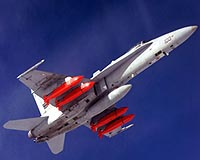| . |  |
. |
Canberra, Australia (UPI) Oct 2, 2009 Australia has reined in advanced development of its controversial electronic warfare self-protection system, known as Project Echidna, to be fitted to helicopters and transport aircraft. The Department of Defense Personnel, Materiel and Science said it has agreed to a Defense Department recommendation to reduce the scope of AIR 5416 Phase 2, which should save around $43.5 million. Modifications will be completed to 12 Black Hawk helicopters to provide a basic level of electronic warfare self-protection. But work on a more advanced equipment suite including the BAE Systems Australian-developed ALR-2002 radar warning receiver will be stopped. "Defense has reassessed the operational requirement and has determined that the fitting of additional electronic warfare self-protection capabilities would have an adverse effect on aircraft availability," the minister for DPMS, Greg Combet, said in a written statement. "Black Hawk helicopters are currently being utilized for a wide variety of roles for the ADF (Australian Defense Force) and it is vital that they continue to be available to fulfill these roles. "Defense also advised the government that the return on investment involved in completing, installing and sustaining the advanced electronic warfare suite would not be justified given the remaining life of the Black Hawk fleet." Project Echidna is the development of an advanced ground system, an integrated electronic warfare mission support system along with an integrated suite controller for the aircraft that coordinates sensors, countermeasures and a human machine interface. It also includes a mission data system for pre-flight planning and post mission analysis, and a series of training aids to support Australian Defense Force staff. Echidna Phase 2A applies the system to the Chinook and Black Hawk Helicopters. Project Echidna has already enhanced the survivability and protection of the Australian Chinook fleet for operations in Afghanistan, Combet noted. "This has included fitting warning systems coupled to flare dispensers to counter heat-seeking missiles and ballistic protection against direct fire weapons. "The 12 Black Hawks to be fitted will have similar levels of electronic warfare self-protection and ballistic protection to that fitted to the Chinooks. Five Black Hawk aircraft have been modified and the remaining seven aircraft will be completed before mid 2010." Project Echidna also includes the modification of all 12 C130H aircraft to provide a missile warning, radar warning and counter measures dispense capability. He stressed that the performance of prime contractor BAE Systems "had met all expectations and that development of the skills, capabilities and technology by BAE Systems during the conduct of the project will pay dividends for Defense and the company into the future. BAE Systems should be congratulated on its performance." The project's checkered contract history began in 1999 when Lockheed Martin, Northrop Grumman, Raytheon and Australia's Tenix were each awarded a contract to provide preliminary designs. The first element of the system, the ALR-2002 radar warning receiver, was already under development by BAE Systems. But in early 2000 the government postponed the project indefinitely. However, in August the Australian Department of Defense said it would restrict involvement in the initial phases of a revised project to just BAE Systems Australia and Tenix Defense Systems. The decision drew heavy criticism from many domestic and international electronic warfare companies that warned the move could mean reduced technology access for the Australian Defense Force in the future. Nonetheless, in May 2001 BAE Systems walked away with an Initial Design Activity contract for Project Echidna. BAE Systems was to perform a system requirements analysis, as well as architectural and detailed design to the sub-system level for electronic warfare self-protection of aircraft including the Blackhawk S-70A-9. Two years later the two competing companies, BAE Systems Australia and Tenix Defense's Systems Division, both located in Adelaide, were appointed to the share the $145 million contract. But BAE was to be prime contractor and remain in charge of development for the ALR-2002 radar warning receiver. Share This Article With Planet Earth
Related Links The latest in Military Technology for the 21st century at SpaceWar.com
 Raytheon Delivers First Joint Standoff Weapon C To Australia
Raytheon Delivers First Joint Standoff Weapon C To AustraliaTucson AZ (SPX) Oct 02, 2009 Raytheon delivered the first Joint Standoff Weapon C to Australia in July for the Royal Australian Air Force's new F/A-18F Hornet fighter aircraft. In addition to the JSOW C, the RAAF has placed an order for the JSOW C-1, which is currently in production; deliveries will begin in 2010. The JSOW C-1 maintains the land attack capability of JSOW C and adds a moving maritime target capability ... read more |
|
| The content herein, unless otherwise known to be public domain, are Copyright 1995-2009 - SpaceDaily. AFP and UPI Wire Stories are copyright Agence France-Presse and United Press International. ESA Portal Reports are copyright European Space Agency. All NASA sourced material is public domain. Additional copyrights may apply in whole or part to other bona fide parties. Advertising does not imply endorsement,agreement or approval of any opinions, statements or information provided by SpaceDaily on any Web page published or hosted by SpaceDaily. Privacy Statement |